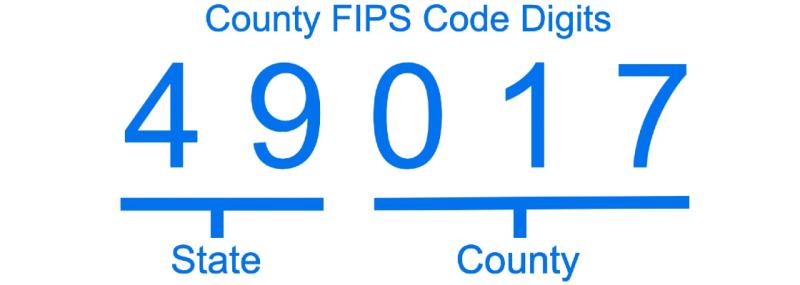What is a FIPS code?
A FIPS code, which stands for Federal Information Processing Standards code, is a standardized geographic coding system used by various government agencies in the United States to uniquely identify geographic areas. These codes were developed by the National Institute of Standards and Technology (NIST) and are primarily used for data processing, record-keeping, and data exchange purposes.
FIPS codes cover various levels of geographic areas, including:
States: Each state in the U.S. is assigned a two-digit FIPS code. For instance, Alabama has the FIPS code 01, and California has the code 06.
Counties: FIPS codes are assigned to counties within each state. These are typically three-digit codes. For example, Los Angeles County in California has the FIPS code 037.
Places and Municipalities: FIPS codes are also used to identify incorporated places, cities, towns, and other municipal entities. These codes are typically five-digit codes. For instance, the city of New York has the FIPS code 3651000.
Census Tracts, ZIP Codes, etc.: FIPS codes are used for smaller geographic units, such as census tracts, ZIP codes, school districts, and other administrative areas for data collection and analysis.
FIPS codes are widely utilized in various government databases, statistical analysis, mapping, emergency services, geographic information systems (GIS), and other applications where precise and standardized identification of geographic areas is necessary. They facilitate data sharing, aggregation, and comparison across different systems and organizations.
However, it's important to note that FIPS codes have been gradually phased out in favor of more modern geographic coding systems, such as the Geographic Names Information System (GNIS) and the newer ANSI codes, like the ANSI INCITS 446-2008 standard. These newer systems offer enhanced functionality and are being adopted to replace the older FIPS codes in many applications.
1. Purposes of a FIPS Code
FIPS codes, or Federal Information Processing Standards codes, serve several important purposes:
Standardization and Uniformity: FIPS codes promote standardization and uniformity in the use of data processing and information technology within the U.S. federal government. They ensure consistency and compatibility across different agencies and departments.
Data Security and Privacy: FIPS codes contribute to data security and privacy by establishing standards for cryptographic algorithms, hash functions, and other security measures. These standards help to protect sensitive government and citizen data.
Interoperability and Compatibility: FIPS codes facilitate interoperability and compatibility between different software and hardware systems used by the federal government. They ensure that systems can communicate effectively and exchange information seamlessly.
Procurement and Acquisition: FIPS codes play a role in government procurement and acquisition processes. Agencies must adhere to FIPS standards when purchasing or developing IT products and services.
Public Trust and Confidence: FIPS codes contribute to public trust and confidence in the government's use of information technology. They demonstrate a commitment to data security, privacy, and interoperability.
2. Assignment and Utilization of FIPS Codes in Various Domains
FIPS codes are assigned and utilized in various domains within the U.S. federal government and beyond:
Data Processing and Information Technology: FIPS codes are widely used in data processing and information technology, including standards for cryptographic algorithms, hash functions, and data formats.
Telecommunications and Networking: FIPS codes are also used in telecommunications and networking, such as standards for wireless technologies and network security protocols.
Government Procurement and Acquisition: FIPS codes are referenced in government procurement and acquisition regulations, guiding agencies in selecting IT products and services that meet federal standards.
Publicly Available Standards: Some FIPS codes are based on publicly available standards developed by organizations like the National Institute of Standards and Technology (NIST) or the International Organization for Standardization (ISO).
International Recognition and Adoption: Some FIPS codes have gained international recognition and adoption, promoting global interoperability and compatibility in IT systems.
3. Types and Levels of FIPS Codes and Their Significance
There are different types and levels of FIPS codes, each with its own significance:
FIPS Publication (FIPS PUB): These publications define specific standards or guidelines for IT products, services, or practices.
FIPS Approved Cryptographic Module (ACM): These modules are tested and validated to meet FIPS cryptographic standards, ensuring their suitability for protecting sensitive government information.
FIPS Federal Information Processing Standard (FIPS-ISP): These standards pertain to administrative and management practices related to IT security, such as risk assessment and incident response.
FIPS Profiles: These documents provide additional guidance or implementation details for specific FIPS standards or publications.
FIPS Validation and Testing: FIPS codes often involve validation and testing procedures to ensure that products, services, or practices meet the specified standards.
The significance of FIPS codes varies depending on the domain and application. In some cases, adherence to FIPS standards is mandatory for government agencies, while in other cases, it may be recommended or considered a best practice. Overall, FIPS codes play a crucial role in ensuring data security, privacy, and interoperability in the U.S. federal government and beyond.


